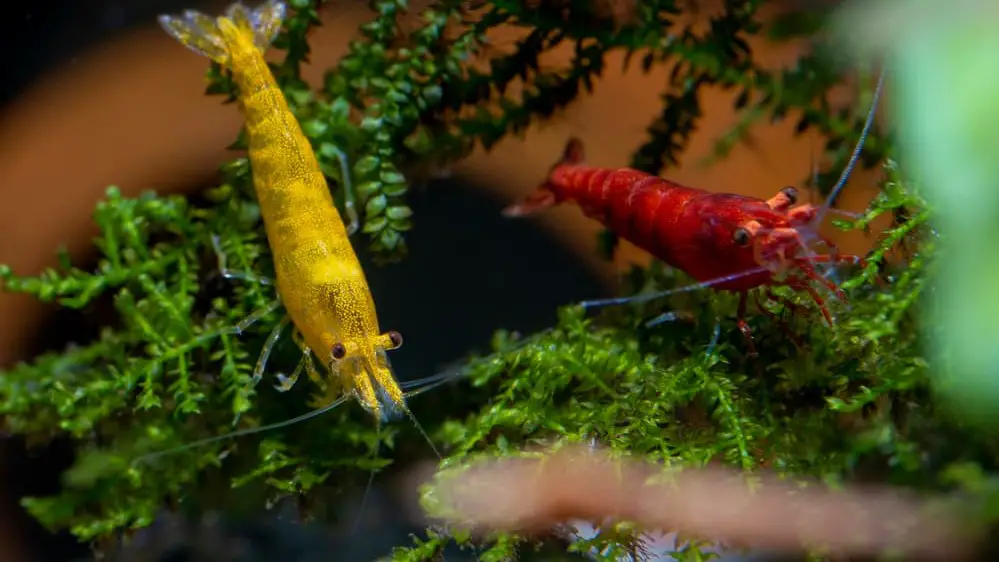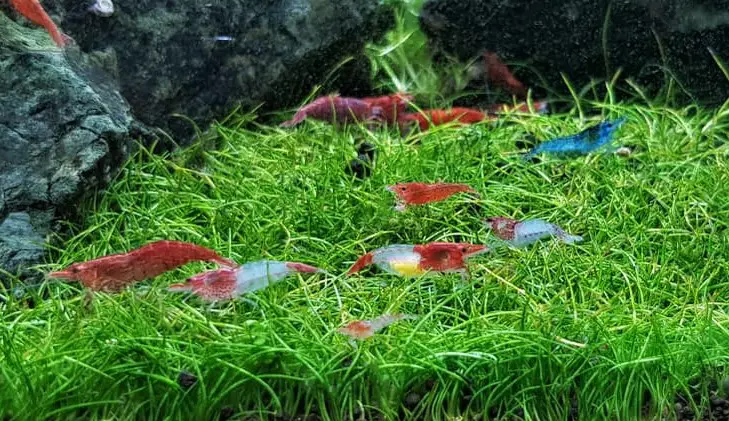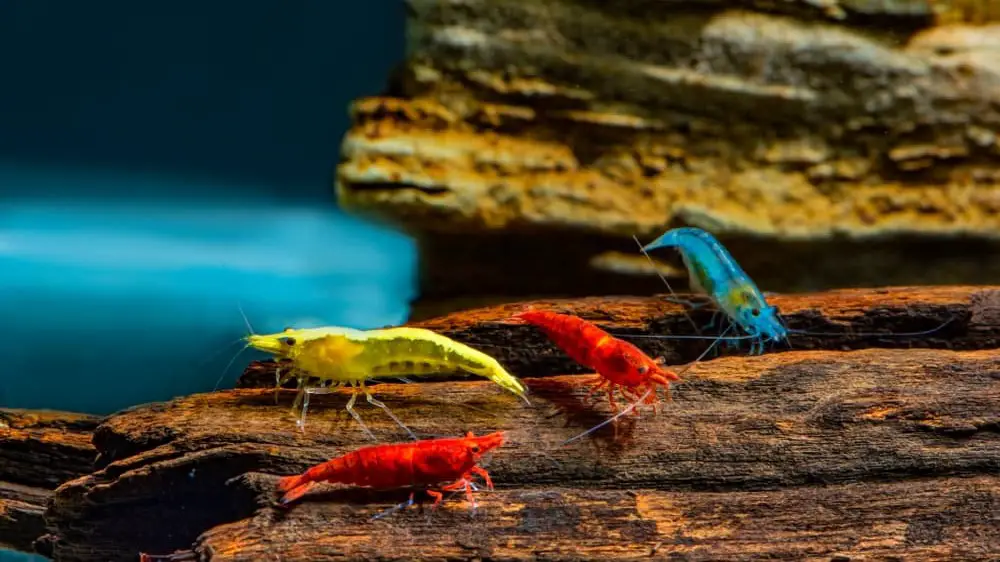Yes, you can mix Neocaridina shrimp, like Cherry Red and Bloody Mary, in the same tank. They might interbreed, leading to a mix of colorations in the offspring. This might not be an issue unless you’re planning to sell purebred shrimp. Also, these breeds have similar water parameter requirements, making them compatible tank mates.
Hello, fellow shrimp enthusiasts! I’m here to share my personal journey in the fascinating world of shrimp keeping, explicitly focusing on the mixing of Neocaridina, or as we commonly call them, “Neos”. When I first started, I was curious, just like you, whether I could house different breeds of Neos in the same tank. Today, I’ll share what I’ve learned about this intriguing topic. Let’s dive in!
History and Evolution of Neocaridina davidi
Neocaridina davidi, colloquially known as “Neos”, is a species of freshwater shrimp native to Taiwan. These shrimps have been part of the local ecosystems for centuries, displaying a wild-type coloration typically ranging from a translucent greenish-brown to a deep, opaque brown. However, their global recognition and popularity in the aquarist community only took off in the late 20th century.
Wild Neocaridina davidi
In their natural habitat, Neocaridina davidi are found in a variety of freshwater environments, from slow-moving streams to ponds and lakes. They are incredibly hardy and adaptable, capable of thriving in various conditions. These characteristics, combined with their small size and peaceful nature, make them an ideal candidate for freshwater aquariums.
Emergence of Color Varieties
The vibrant color varieties of Neos we see today are a result of selective breeding efforts, driven by the demands of the aquarist community. The initial breeding efforts began with the ‘Cherry Red’ variety, which was achieved by isolating and breeding individuals showing a stronger red coloration.
The process of selective breeding involves identifying individual shrimps with desirable traits— in this case, color— and breeding them together. Over successive generations, these color traits become more pronounced. This is a time-consuming process, often taking many generations to produce a stable, true-breeding color variety.
A Rainbow of Neos
Following the success of the Cherry Red shrimp, breeders worldwide took to developing their unique color varieties. Today, the Neocaridina davidi species boasts an impressive array of colors, including but not limited to Red Cherry, Bloody Mary, Blue Velvet, Yellow Golden Back, Orange Sakura, Green Jade, and Black Rose. Each variety is a testament to the patient and meticulous work of breeders.
The Future of Neocaridina davidi
With an ever-growing interest in aquascaping and shrimp keeping, the future of Neocaridina davidi seems vibrant as their varied color palette. Breeders continue to experiment with selective breeding, resulting in new and exciting color varieties.
The journey of Neocaridina davidi, from the wild streams of Taiwan to the heart of the global aquarist community, is a remarkable example of human creativity meeting natural adaptability. As we explore and experiment, who knows what color will be the next addition to the Neocaridina family!
Remember, whether you’re a novice shrimp keeper or a seasoned aquarist, every Neocaridina shrimp in your tank is a part of this extraordinary journey. As we enjoy the beauty and diversity they bring to our aquariums, let’s also celebrate and respect their unique history and evolution.

Mixing Shrimp Breeds
Mixing shrimp breeds in the same tank can be an exciting venture. It allows you to enjoy a variety of colors and behaviors in a single aquarium. The first thing to consider when mixing shrimp breeds is compatibility. Not all shrimp breeds can live together peacefully. Another crucial aspect to consider is the potential for interbreeding. Lastly, consider the visual aspect. Mixing breeds with contrasting colors can create a stunning display.
Neocaridina Shrimp Breeds and Best Colors for a Skittles Tank
Neocaridina davidi, or Neos, are a popular choice for beginners due to their hardiness and vibrant colors. Each breed of Neos has been selectively bred for their unique coloration. For instance, the Cherry Red Shrimp and the Bloody Mary Shrimp are both variants of Neocaridina davidi, selectively bred for their intense colors.
Creating a “Skittles” tank, a term coined by shrimp keepers to describe a tank with a mix of colorful Neocaridina shrimp, can be a fun and rewarding project. The goal is to create a vibrant, diverse display that’s reminiscent of a bag of Skittles candy. Here are some of the best Neocaridina colors to consider for a Skittles tank:
- Cherry Red Shrimp: Bright, solid red that pops against green plants and dark substrate.
- Blue Velvet Shrimp: Deep blue providing a striking contrast to the reds, yellows, and oranges.
- Yellow Golden Back Shrimp: Vibrant yellow with a golden stripe down their back.
- Orange Sakura Shrimp: Bright, solid orange for a warm, vibrant color.
- Green Jade Shrimp: Unique, solid green offering a contrast to the more common reds and blues.
- Black Rose Shrimp: Deep, dark coloration providing a stunning contrast to the brighter colors.
Consider how these colors will look together and against your tank’s background, substrate, and plants. With the right mix of colors, you can create a visually stunning display.

Water Parameters and Their Importance for Neos
Neocaridina davidi, or Neos, are known for their hardiness and adaptability, making them a popular choice among shrimp keepers. Even though they’re relatively easy to care for, it’s crucial to provide them with the right water parameters to ensure their health and longevity. Here are the ideal water parameters for Neos:
| Water Parameter | Ideal Range for Neos | Importance |
|---|---|---|
| Temperature | 65 to 85°F (18 to 29°C) | Affects the metabolism and overall health of the shrimp. |
| pH Level | 6.5 to 8 | Affects the shrimp’s ability to carry out essential biological processes. |
| General Hardness (GH) | 4 to 8 degrees | Affects the shrimp’s ability to molt and reproduce. |
| Carbonate Hardness (KH) | 3 to 10 degrees | Affects the stability of the pH level in the tank. |
| Ammonia | Not readable on any test kit | Ammonia is toxic to shrimp. Levels should be so low that they’re undetectable with a test kit. |
| Nitrite | Low levels | High levels of nitrite can be harmful to shrimp, affecting their respiration and immune system. |
| Nitrate | Low levels | While less toxic than ammonia and nitrite, high levels of nitrate can still be harmful to shrimp. |
Different breeds of Neos, such as Cherry Red, Bloody Mary, and Blue Velvet, generally share similar water parameter requirements. Regular water changes and a well-cycled tank can help maintain optimal water quality.
Tips for Breeding Loads of Shrimp
Breeding loads of shrimp can be a rewarding experience, but it requires some specific care and maintenance practices. Here are some tips to help you create the ideal conditions for your shrimp to breed:
Feeding: Shrimp are omnivores and will eat a variety of foods. However, if you’re looking to encourage breeding, consider feeding them powdered fish flakes . These are high in protein, which can help promote breeding. Just make sure to feed sparingly to avoid overfeeding and potential water quality issues.
. These are high in protein, which can help promote breeding. Just make sure to feed sparingly to avoid overfeeding and potential water quality issues.
Water Changes: Regular water changes are crucial for maintaining optimal water quality in your shrimp tank. Aim to do a 30% water change every few weeks. This helps to remove waste and replenish essential minerals that your shrimp need to breed and molt successfully.
every few weeks. This helps to remove waste and replenish essential minerals that your shrimp need to breed and molt successfully.
Plants: Fast-growing stem plants are a great addition to any shrimp tank. They help to absorb excess nutrients, provide cover for your shrimp, and offer additional surfaces for biofilm to grow, which shrimp love to graze on. Some good choices include Hornwort, Water Wisteria, and Anacharis.
Over Filtering: Shrimp produce very little waste, so over filtering isn’t usually necessary. However, if you’re planning to breed loads of shrimp, over filtering with large sponge filters can help maintain excellent water quality. Sponge filters also provide a great surface for biofilm to grow, providing an additional food source for your shrimp.
Remember, breeding shrimp successfully requires patience and attention to detail. By providing the right food, maintaining good water quality, adding plants, and considering your filtration, you can create an environment where your shrimp can thrive and reproduce.

Suitable Tank Mates for Neocaridina Shrimp
When it comes to choosing tank mates for your Neocaridina shrimp, it’s important to select species that are peaceful and won’t see your shrimp as a snack. Here are some small, peaceful fish that can coexist well with a Neocaridina shrimp colony:
- Bristlenose Plecos: These are a personal favorite of mine. I’ve had success keeping Bristlenose Plecos with my Neocaridina shrimp, even while breeding thousands of them. Bristlenose Plecos are peaceful and primarily eat algae, so they won’t bother your shrimp.
- Pygmy Corydoras: These tiny catfish are peaceful and active. They spend most of their time at the bottom of the tank, so they won’t disturb your shrimp.
- Endler’s Livebearers: These are small, colorful fish that are known for their peaceful nature. They’re a great choice if you want to add some color and movement to your tank.
- Celestial Pearl Danios: These small, brightly colored fish are peaceful and won’t bother your shrimp. They’re also quite beautiful and can add a splash of color to your tank.
- Otocinclus Catfish: These are small, peaceful fish that are great for controlling algae in your tank. They won’t bother your shrimp and can coexist peacefully with them.
Remember, even with peaceful fish, it’s important to provide plenty of hiding spots for your shrimp. This can help them feel safe and reduce stress, which is especially important if you’re trying to breed your shrimp.
Selling Considerations for Mixed Breed Shrimp
If you’re considering selling shrimp, it’s important to understand how interbreeding can affect your prospects. While a tank full of mixed breed Neos can be a beautiful sight, it might not be as appealing to potential buyers. This is because shrimp enthusiasts often prefer specific breeds with pure coloration.
When different breeds interbreed, the resulting offspring can display a mix of colors or revert to wild-type coloration. While this can add diversity to your tank, it can make it harder to sell the shrimp as specific breeds. For instance, if a buyer is looking for pure Cherry Red Shrimp, they might not be interested in shrimp that are a mix of Cherry Red and Bloody Mary.
Therefore, if you’re planning to sell shrimp, it might be better to keep different breeds in separate tanks to maintain pure color lines. This way, you can ensure that you’re providing buyers with the specific breeds they’re looking for.

Conclusion
In conclusion, creating a “Skittles” tank with Neocaridina davidi, or Neos, is an exciting and rewarding project. By choosing from a wide array of colors, from Cherry Red and Blue Velvet to Green Jade and Black Rose, you can create a stunning, vibrant display that brings life and color to any space.
However, the success of your shrimp-keeping journey doesn’t solely depend on the variety of colors. It’s also critically important to maintain optimal water conditions. A temperature range between 65 to 85°F (18 to 29°C), pH levels from 6.5 to 8, and low levels of ammonia, nitrite, and nitrate are just some of the critical water parameters that can significantly influence the health and longevity of your Neos.
By carefully managing these aspects, you can ensure a thriving and diverse shrimp community.
If you have any questions, please don’t hesitate to contact me through the contact form!
Happy Shrimp Keeping!
Frequently Asked Questions
Q. Can Neocaridina shrimp live with other types of shrimp? A. Yes, Neocaridina shrimp can live with other types of shrimp, such as Amano or Ghost shrimp, which have different water parameter requirements and won’t interbreed with Neos.
Q. How many Neocaridina shrimp can I keep in my tank? A. As a general rule, you can keep 10 Neocaridina shrimp per gallon of water. However, this can vary depending on the size of your tank and the quality of your filtration system.
Q. What do Neocaridina shrimp eat? A. Neocaridina shrimp are omnivores and will eat a variety of foods. This includes algae, biofilm, vegetables, and commercial shrimp food.
Q. How long do Neocaridina shrimp live? A. With proper care, Neocaridina shrimp can live for 1 to 2 years on average.
Q. How can I prevent my Neocaridina shrimp from interbreeding? A. The best way to prevent your Neocaridina shrimp from interbreeding is to keep different breeds in separate tanks. This ensures that each breed maintains its unique coloration.
